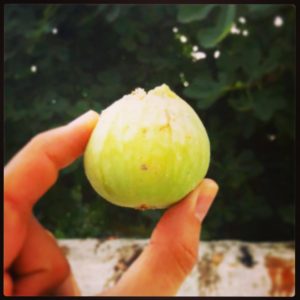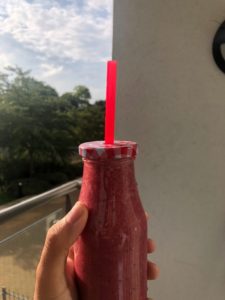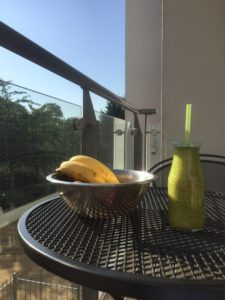Kefir smoothies: easy-to-make, nutritious & delicious
I was first introduced to kefir a few years ago, while on holidays in Greece. This fermented milk drink is not only rich in nutrients, such as protein, calcium and vitamins, but it also contains probiotics. These live micro-organisms (bacteria and yeasts), often described as ‘good’ or ‘friendly’ bacteria, can have various health benefits. For example, they may help sufferers with indigestion, IBS (Irritable Bowel Syndrome) and (rather surprisingly) lactose intolerance. Since kefir has recently become widely available in the UK, I’ve started using it in my recipes as a substitute for yogurt or even milk.

Inspired by the fresh fruit I had whilst island-hopping in the Cyclades (especially figs, pomegranates, and kiwis), I have come up with three recipes for easy-to-make, nutritious and delicious smoothies. Even though kefir has a rather sour taste, the addition of fruit covers this up, so the kefir smoothies taste as sweet as smoothies ought to.
Figs
Figs are not only delicious but they are also very nutritious. They are rich in minerals (potassium, calcium, magnesium, iron and copper) and vitamins (A, E and K), as well as a great source of fibre. They also contain prebiotics (food ingredients that induce the growth of probiotics). A diet that contains moderate amounts of figs may with hypertension (high blood pressure), constipation and weight control.
Pomegranates
Pomegranates are also rich in minerals (potassium), vitamins and fibre; however, most of this fibre is found in the white parts of the fruit, rather than the seeds. They are also high in antioxidants, which contribute to their anti-inflammatory properties. A diet rich in antioxidants may reduce the risk of a number of physical health problems, such as heart disease, some types of cancer, diabetes, Alzheimer’s disease, arthritis and obesity.

Kiwis
Kiwis are also a good source of minerals (potassium), vitamins (folate, C, E and K), fibre and antioxidants. A diet containing moderate amounts of kiwis may help reduce the risk of asthma, certain types of cancer, diabetes, hypertension, cardiovascular, digestive and eye problems.
Bananas
As you can see, I have used bananas in all three recipes. This is because bananas provide the perfect creamy smoothie base and their flavor complements a variety of fruits, including fig, pomegranate and kiwi – the real stars here. Sweet as bananas are, there is no need to add extra sweeteners, making the kefir smoothies even healthier (please note that I have a very sweet tooth). At the same time, bananas have a number of health benefits. They are a good source of minerals (especially potassium), vitamins (B6), fibre and prebiotics. Moderate banana consumption may help reduce the risk of asthma, certain types of cancer, hypertension, diabetes, cardiovascular disease and digestive problems. It can also help with cognition and mental health, as bananas contain tryptophan, an amino acid that studies suggest plays a role in preserving memory and boosting mood.
Since I would hardly describe myself as a minimalist, I rarely agree with the rule that less is more; when it comes to smoothies, however, I do make an exception to this rule. I therefore use only three ingredients: kefir, fresh fruit (figs, pomegranates, or kiwis) and fresh bananas.
Here are my kefir smoothie recipes:
Fig and banana kefir smoothie
Ingredients
250 ml kefir
4 fresh figs, chopped
1 banana, peeled and chopped
I have to admit that I would normally eat fresh figs whole, rather than blend them in a smoothie. However, if they are too ripe, why not try this recipe?
Pomegranate and banana kefir smoothie
Ingredients
250 ml kefir
200 grams pomegranate seeds
1 banana, peeled and chopped
Due to the pomegranate seeds, the texture of this bright red smoothie is quite crunchy (I’m therefore not quite so sure whether it should be called a smoothie!).
Kiwi and banana kefir smoothie
Ingredients
250 ml kefir
2 fresh kiwis, peeled and chopped
1 banana, peeled and chopped
This bright green smoothie is my favourite one out of these three. It looks great, and it tastes even better!

Method
Place all the ingredients in the jar of a blender, and blend until smooth.
If you’d like extra crunchiness, as well as an additional source of protein, you could add a handful of chia and/or other seeds (i.e. pumpkin, flax).
Enjoy!
Alex
(the Traveling Psychiatrist)
Further reading
To find out more about kefir and its health benefits (especially in connection with Irritable Bowel Syndrome, depression and anxiety), read The Kefir Solution: Natural Healing for IBS, Depression and Anxiety by Shann Nix Jones (a review of this book will soon follow).
For more recipes with kefir, click here or read my post ‘Alex’s portokalopita (orange pie)’.
For more recipes and to read more about the health benefits of the ingredients I’ve used in my smoothies, click here or here (kefir), here or here (figs), here or here (pomegranates), here (kiwis), and here, here or here (bananas).
To read more about the health benefits of bananas, as well as about a number of other interesting topics, check Davy and Tracy’s blog.
Last but not least, to follow my travels around the world, simply subscribe to the Traveling Psychiatrist (just click on the menu on the left hand side).
One Comment
Pingback: